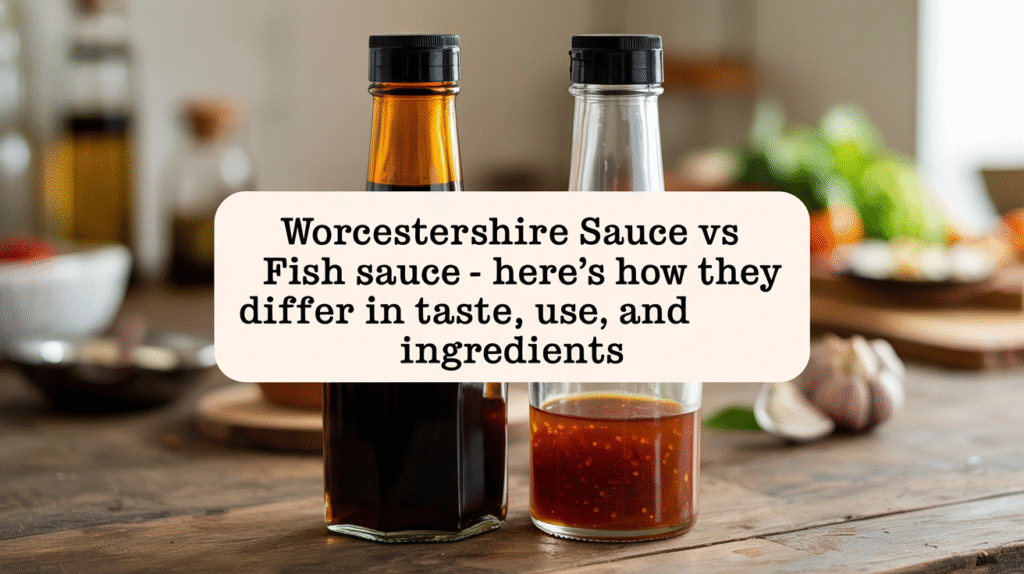Affiliate Disclosure: PantryBrands.co.uk is a participant in the Amazon.co.uk Associates Programme. As an Amazon Associate, we earn from qualifying purchases made through links on this site.
Worcestershire sauce and fish sauce may appear similar in their salty, savoury flavour profiles, but they are distinctly different in origin, ingredients, and how they’re used in cooking. Worcestershire is a British condiment made from a fermented blend of vinegar, molasses, anchovies, and spices, while fish sauce is an Asian staple made by fermenting fish with salt.

Understanding the key differences can help you choose the right sauce for the dish, especially when substituting in recipes or cooking across cultures.
The Main Difference Is in the Base Ingredients
While both sauces share a fermented, umami-rich character, they come from entirely different culinary traditions.
Worcestershire Sauce Ingredients
Worcestershire sauce is known for its complex, layered flavour created from a mixture of fermented and sweet ingredients.
- Typically includes vinegar, molasses, anchovies, tamarind, garlic, onions, and spices
- Aged in barrels for months to develop a mellow, balanced taste
Fish Sauce Ingredients
Fish sauce is more straightforward and intensely salty.
- Made from fermented anchovies or other small fish mixed with salt
- No sweeteners, spices, or acids are added
This minimalist composition results in a sharper, more pungent sauce that is more intense than Worcestershire.
Flavour Comparison: Umami, Sweetness, and Salt Levels
The difference in ingredients leads to different flavour impacts on dishes.
Worcestershire Sauce Flavour Profile
Known for being bold but balanced, Worcestershire adds depth without overwhelming other ingredients.
- Sweet, tangy, salty, and slightly spicy all at once
- Contains molasses and tamarind for a rounder finish
Fish Sauce Flavour Profile
Fish sauce is more aggressive in flavour and aroma, particularly when raw.
- Extremely salty and strong with a sharp fermented scent
- Lacks sweetness and acidity, making it more direct in flavour
In dishes, fish sauce tends to dominate unless balanced with lime juice, sugar, or chilli.
Culinary Uses: Where Each Sauce Works Best
Though they both add umami, the dishes they suit are very different due to cultural roots and taste profiles.
Worcestershire Sauce Uses in Cooking
A versatile Western condiment found in many British and American recipes.
- Common in meat marinades, gravies, stews, and cheese dishes
- Used in cocktails like the Bloody Mary and in dishes like Shepherd’s Pie or Welsh Rarebit
Fish Sauce Uses in Cooking
An essential ingredient in many Southeast Asian cuisines, especially Thai and Vietnamese.
- Used in curries, dipping sauces, stir-fries, and noodle dishes
- Commonly paired with lime, sugar, and garlic in sauces like Nuoc Cham
Using the wrong sauce in the wrong dish can result in an unbalanced or unintended flavour.
Can They Be Substituted for Each Other?
Sometimes, but not always. Their intensity and ingredients don’t always translate well across cuisines.
When It’s Safe to Substitute
You can replace one with the other in recipes that only require a small amount of savoury depth.
- In stews or soups, a teaspoon of either can add umami
- Mixing fish sauce with a bit of sugar and vinegar can mimic Worcestershire
When Not to Substitute
Avoid substitution when the sauce is central to the dish’s taste or culture.
- Don’t use fish sauce in a Bloody Mary or cheese toastie
- Don’t use Worcestershire sauce in Pad Thai or Pho
Instead, use sauces that are closer in profile, like soy sauce or tamari for either option.
Which One Is Healthier?
Both are used in small amounts, so their impact on your diet is minimal, but there are slight differences.
Sodium Levels
Fish sauce typically contains more sodium per serving than Worcestershire.
- Fish sauce: 1300–1500mg sodium per tablespoon
- Worcestershire: 65–200mg sodium per teaspoon
Dietary Suitability
Worcestershire often contains anchovies and gluten, unless labelled otherwise.
- Fish sauce is gluten-free but not vegetarian or vegan
- Vegan Worcestershire alternatives are available
Shelf Life and Storage Tips
Both sauces are shelf-stable and last a long time, especially if stored properly.
Worcestershire Sauce Storage
Store in a cool, dark place. Refrigeration is optional after opening.
- Can last up to 3 years unopened
- Once opened, best used within 6–12 months
Fish Sauce Storage
Doesn’t spoil easily due to high salt content.
- Can be kept in the cupboard, but fridge storage retains quality
- Lasts over a year once opened
FAQs About Worcestershire Sauce vs Fish Sauce
Here are some questions and answers about the differences between Worcestershire sauce and fish sauce.
Can I use fish sauce instead of Worcestershire sauce?
Yes, but only in small amounts and with adjustments. Fish sauce is saltier and lacks sweetness, so you may need to add vinegar or sugar to balance it.
Is Worcestershire sauce made from fish?
Yes, traditional Worcestershire contains fermented anchovies. However, vegan versions exist that use tamarind, soy, and spices instead.
Why does fish sauce smell so strong?
The high salt and fermentation of anchovies create a strong, pungent aroma. The smell softens during cooking and contributes rich umami to the dish.
Is Worcestershire sauce gluten-free?
Not always. Many versions contain malt vinegar, which includes gluten. Gluten-free options are available, so always check the label.
Which one is better for Asian recipes?
Fish sauce is the authentic choice for most Asian recipes. Worcestershire may be used in fusion dishes but lacks the sharp depth fish sauce provides.
